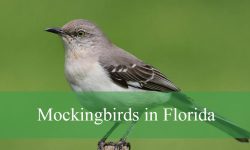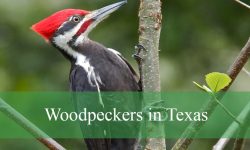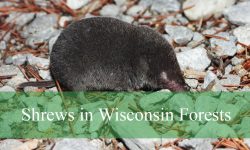Florida is home to a stunning diversity of wading birds, making it one of the best places in North America to observe herons in their natural habitats. Whether you’re exploring coastal lagoons, freshwater marshes, or urban wetlands, you’re likely to encounter several species of these elegant, long-legged birds. This guide will introduce you to the 12 types of herons in Florida, complete with pictures and identification tips to help you recognize each one in the wild.
Among the types of herons in Florida, nine are considered true native heron species that can be seen throughout the year. In addition to these, birdwatchers can also spot three elusive bittern species and the adaptable Cattle Egret, which, while technically not a true heron, is closely related and often seen in the same environments. Together, they form a richly varied heron community that thrives across the state’s diverse ecosystems.
From the massive Great Blue Heron to the tiny, secretive Least Bittern, each species has its own unique appearance, behavior, and preferred habitat. In the sections below, you’ll find detailed descriptions and photos of all 12 types of herons in Florida, making it easier than ever to identify and appreciate these fascinating birds on your next outdoor adventure.
Common Types of Herons Found in Florida
Great Blue Heron (Ardea herodias)
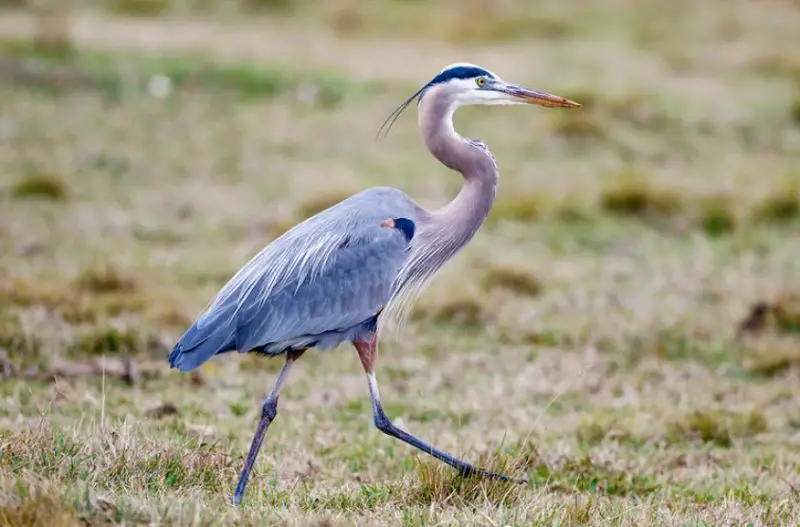
The Great Blue Heron is the largest heron species in North America and is a familiar sight across Florida’s wetlands. It stands over four feet tall with an impressive wingspan that can reach up to seven feet. This bird’s stature is accentuated by its long neck, dagger-like bill, and lanky legs, all of which contribute to its elegant and deliberate movements. Its overall plumage is a muted bluish-gray with a black stripe over the eye and long plumes on the chest and back during breeding season.
Identification of the Great Blue Heron is relatively straightforward due to its large size and distinct coloration. While in flight, its neck coils into an “S” shape, unlike cranes that fly with their necks outstretched. The contrast of its black head plume and pale face adds to its distinguished appearance. Juvenile herons lack the black head stripe and have duller coloration overall, which can help in distinguishing between age groups.
In terms of size, the Great Blue Heron typically measures between 38 and 54 inches in length and weighs about 5 to 6 pounds. Its long legs make it well-suited for wading in deep water, and its sharp bill is used to spear or snatch up fish, amphibians, and even small mammals. It often stands still for long periods, waiting to strike with lightning-fast precision.
This species is found year-round in Florida, frequenting a wide range of freshwater and saltwater habitats including marshes, swamps, lakes, rivers, mangroves, and estuaries. It is especially common in places like the Everglades, St. Johns River basin, and coastal regions throughout the peninsula and panhandle. Its adaptability to different aquatic environments makes it one of the most successful and widespread herons in the state.
Great Egret (Ardea alba)
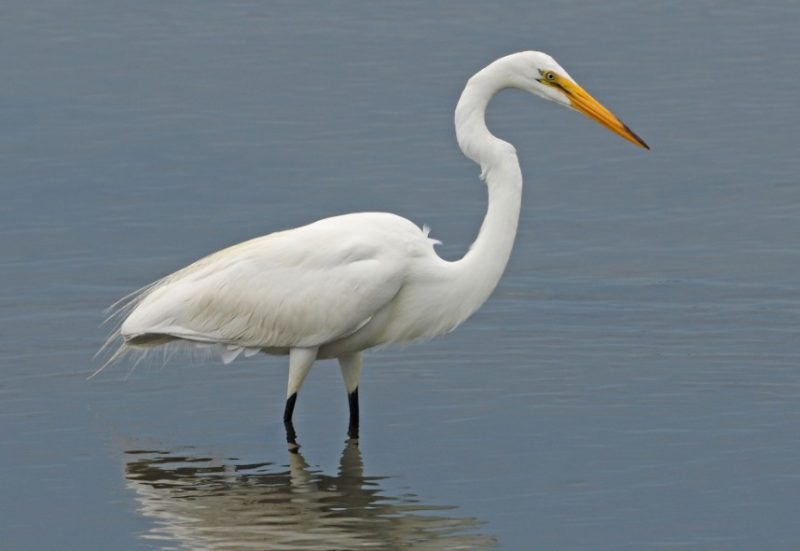
The Great Egret is a striking white heron known for its elegant shape and stately presence in Florida’s wetlands. It stands tall at around 3.3 feet with a long neck and straight yellow bill that it uses to hunt for fish and other small aquatic creatures. The bird’s snowy white plumage shines in the sun, making it one of the most iconic wading birds in the state. During the breeding season, it displays long, delicate plumes on its back, which were once heavily sought after in the plume trade.
When identifying the Great Egret, look for its all-white body, bright yellow bill, and black legs and feet. These features help distinguish it from similar species like the Snowy Egret, which has yellow feet and a black bill. In flight, the Great Egret folds its neck into an S-shape and displays slow, deliberate wingbeats, making it easy to recognize.
The bird measures about 37 to 41 inches in length and weighs around 2 to 2.5 pounds. Its wingspan can extend up to 57 inches, giving it a graceful presence in the sky. Although slightly smaller than the Great Blue Heron, it still dominates many shallow wetland habitats with its size and confident demeanor.
In Florida, the Great Egret is found in almost every aquatic habitat, from inland marshes and swamps to coastal mangroves and tidal flats. It is commonly seen in the Everglades, along the Gulf and Atlantic coasts, and in central Florida’s lakes and wetlands. Its adaptability and wide distribution make it a common yet always impressive sight across the state.
Snowy Egret (Egretta thula)
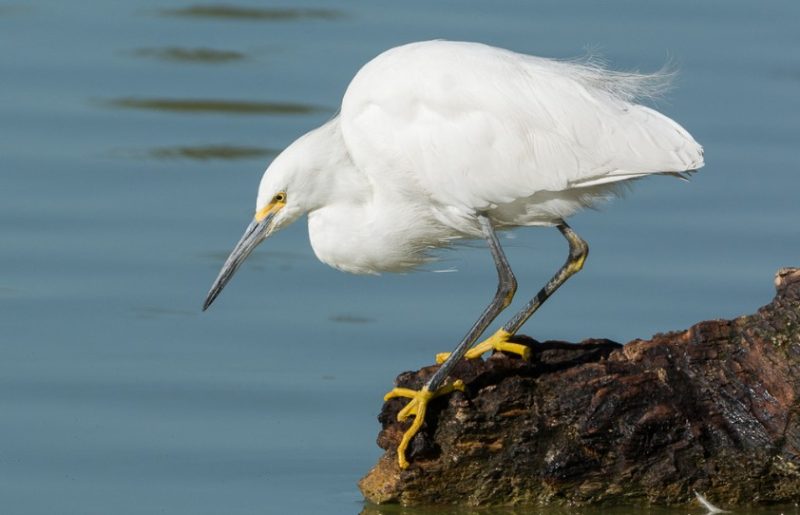
The Snowy Egret is a smaller, elegant white heron that is especially known for its contrasting black bill, black legs, and vivid yellow feet. It has a slender build and active hunting style, often seen darting through shallow water or stirring the mud with its feet to flush out prey. This bird’s beautiful plumage, coupled with its energetic behavior, makes it one of the most charismatic herons in Florida.
Identification of the Snowy Egret is made easy by its combination of black legs and “golden slippers”—the bright yellow feet that are unique among herons. During the breeding season, adults develop wispy plumes on their heads, necks, and backs, which add to their ornate appearance. The Snowy Egret’s bill is thin and black, contrasting sharply with the white feathers and yellow lores around the eyes.
This species is relatively small compared to other herons, measuring about 22 to 26 inches in length with a wingspan of up to 39 inches. Despite its delicate appearance, it is a fierce and agile hunter, feeding primarily on fish, shrimp, insects, and small amphibians. Its active foraging behavior often makes it easy to spot, especially in open shallows.
Snowy Egrets are widespread throughout Florida and can be found in both freshwater and saltwater environments. They inhabit marshes, lagoons, estuaries, mangroves, and even roadside ditches. From the Panhandle to the Keys, their presence is nearly constant, especially in warmer months when breeding colonies form in coastal and inland rookeries.
Little Blue Heron (Egretta caerulea)
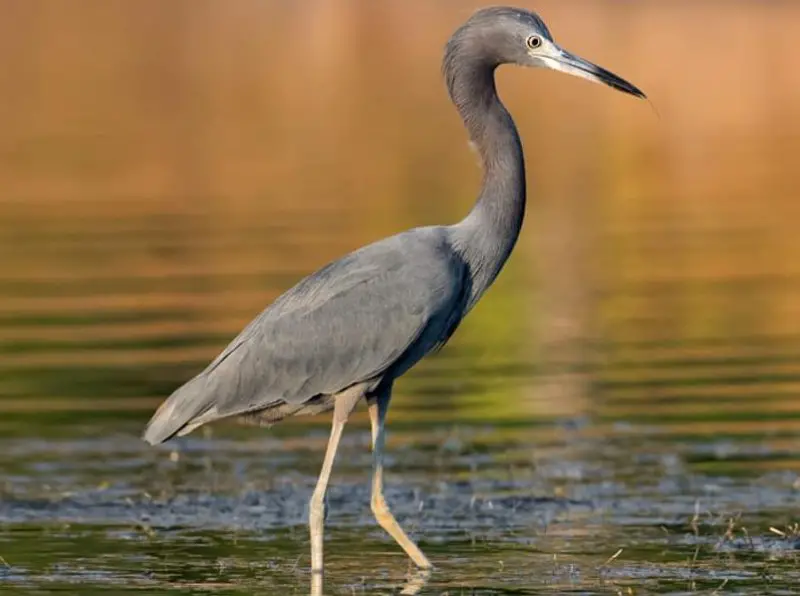
The Little Blue Heron undergoes a fascinating transformation as it matures, making it a unique species among Florida’s herons. Adults have a uniform slate-blue body with a maroon-burgundy head and neck, while juveniles are completely white, resembling Snowy Egrets. This change in plumage provides camouflage benefits and also helps reduce aggression from older herons during feeding.
When identifying a mature Little Blue Heron, look for its blue-gray body, maroonish neck, and pale blue bill with a black tip. Juveniles can be confused with Snowy Egrets, but they can be distinguished by their greenish legs and duller facial skin. As they transition from white to blue, they often show a mottled appearance that’s unmistakable during their second year.
This species is medium-sized, measuring about 24 inches long with a wingspan of approximately 40 inches. It is lighter and more delicate in build than the Great Egret or Great Blue Heron. The Little Blue Heron tends to be a slow and methodical forager, often walking slowly through shallow water to stalk prey such as fish, frogs, and insects.
In Florida, Little Blue Herons are common residents in freshwater habitats such as marshes, swamps, lakes, and ponds. They are also found in coastal mangroves and estuaries but are more frequently associated with inland wetlands. They breed throughout the state, including central and southern regions, and are often seen nesting in mixed colonies with other wading birds.
Tricolored Heron (Egretta tricolor)

The Tricolored Heron is a graceful and slender bird distinguished by its unique blend of slate-blue, lavender, and white plumage. It has a long neck, thin bill, and active foraging behavior that sets it apart from other wading birds. Its chest and underbelly are bright white, contrasting beautifully with the darker plumage of its back and wings. During the breeding season, the colors intensify, and it develops delicate plumes on its head and neck.
In terms of identification, the Tricolored Heron can be recognized by its tricolored body, long yellow legs, and blue-gray bill with a black tip. The white stripe down the neck and white belly are distinctive features not found in other Florida herons. In flight, it shows a striking combination of dark upperparts and white underparts, with graceful wingbeats and a tucked neck.
This heron is medium-sized, typically measuring about 26 inches in length with a wingspan of around 36 inches. It is slim and lightweight, making it an agile and energetic forager. It often dashes through shallow water in pursuit of fish and invertebrates, sometimes using its wings to corral prey into confined areas for easier capture.
Tricolored Herons are widespread in Florida’s coastal regions, especially in salt marshes, mangrove swamps, tidal flats, and lagoons. They also venture into freshwater habitats but are most often associated with estuarine environments. The species is a year-round resident in the state, with strong breeding populations in the Everglades, coastal islands, and wildlife refuges along both the Atlantic and Gulf Coasts.
Reddish Egret (Egretta rufescens)
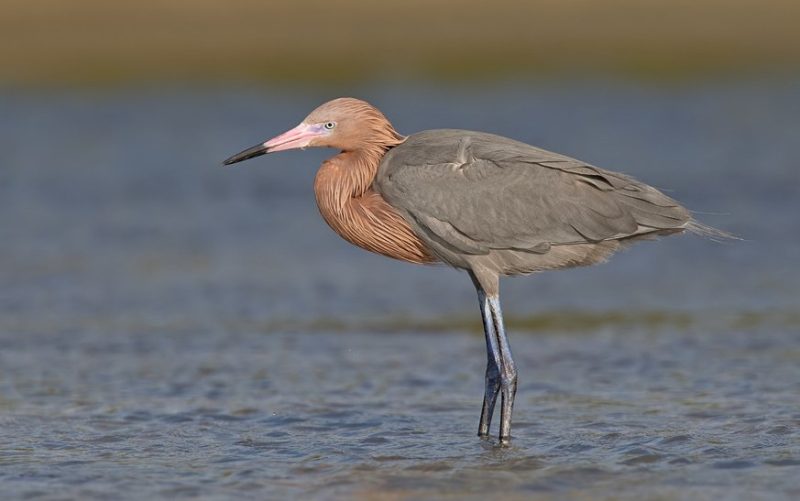
The Reddish Egret is one of the most charismatic and visually distinctive herons found in Florida, though it is relatively uncommon compared to its cousins. This medium-to-large heron displays a unique appearance with a shaggy reddish-brown neck, slate-gray body, and long bluish legs. It also has a bicolored bill—pink at the base and black at the tip—which further sets it apart. A white morph of this species also exists and is less frequently seen but equally striking.
What truly makes the Reddish Egret stand out is its eccentric foraging behavior. It is famous for performing dramatic, energetic “dances” while chasing fish in shallow coastal waters. These movements include flapping, spinning, and darting—sometimes with wings extended to create shade that helps spot prey. This heron is an active and agile hunter, often providing a spectacle for birdwatchers along Florida’s coastlines.
This species measures about 27 to 32 inches in length with a wingspan of up to 48 inches. Despite its medium size, it has a bold presence due to its shaggy plumage and vigorous movements. Its long legs and slightly decurved bill are well-adapted for hunting in tidal flats, lagoons, and estuaries, where water levels are low and prey is abundant.
In Florida, the Reddish Egret is mostly restricted to southern and coastal regions, particularly around the Florida Keys, Everglades National Park, and parts of the Gulf Coast such as Sanibel Island and Tampa Bay. It prefers saltwater habitats over freshwater and nests in isolated mangrove islands. Though less common than other herons, it is a prized find for bird enthusiasts in the state.
Green Heron (Butorides virescens)
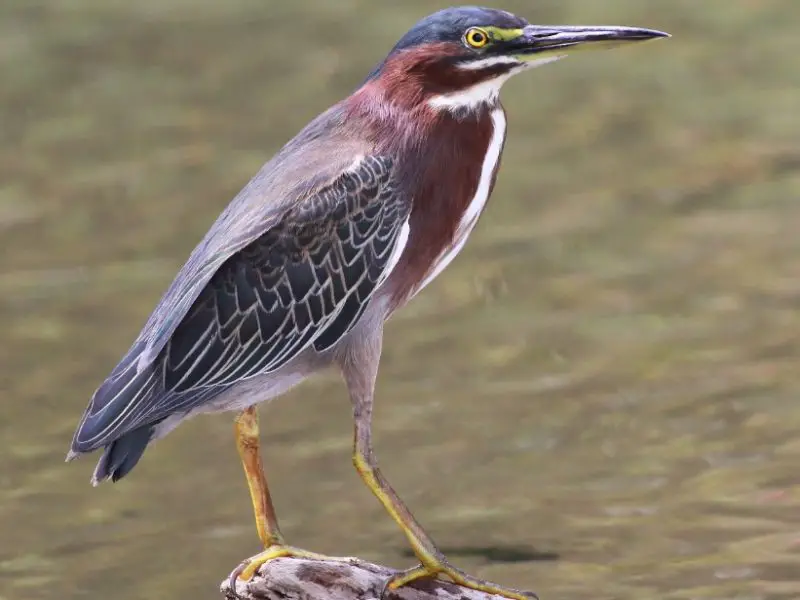
The Green Heron is a small but clever heron species that often goes unnoticed due to its secretive nature and compact size. It has a striking appearance with a deep chestnut-colored neck, greenish-black cap, dark green back, and short yellow legs. When alarmed or hunting, it stretches its neck, but at rest, it appears stocky and hunched, often blending into its surroundings.
Identification of the Green Heron is easiest when it’s perched near the water’s edge. Its bright orange or yellow legs and sharp yellow eyes are noticeable, as is its straight, dark bill. During the breeding season, adults develop subtle plumes on their head and back, and their legs may turn more orange. Juveniles are browner with streaked necks, making them slightly more difficult to recognize at a glance.
This species is small, measuring only about 16 to 18 inches in length with a wingspan of up to 26 inches. Despite its diminutive size, the Green Heron is a proficient and patient hunter. It often uses tools—like dropping insects or twigs on the water’s surface—to lure fish into striking distance, a rare behavior among birds and a sign of their intelligence.
In Florida, Green Herons are widespread and can be found throughout the state year-round. They inhabit freshwater wetlands, marshes, swamps, ponds, and mangrove-lined shores. They are especially common in densely vegetated areas where they can stay hidden while stalking prey. Although small and quiet, their unique behaviors make them a favorite among observant birdwatchers.
Black-crowned Night Heron (Nycticorax nycticorax)
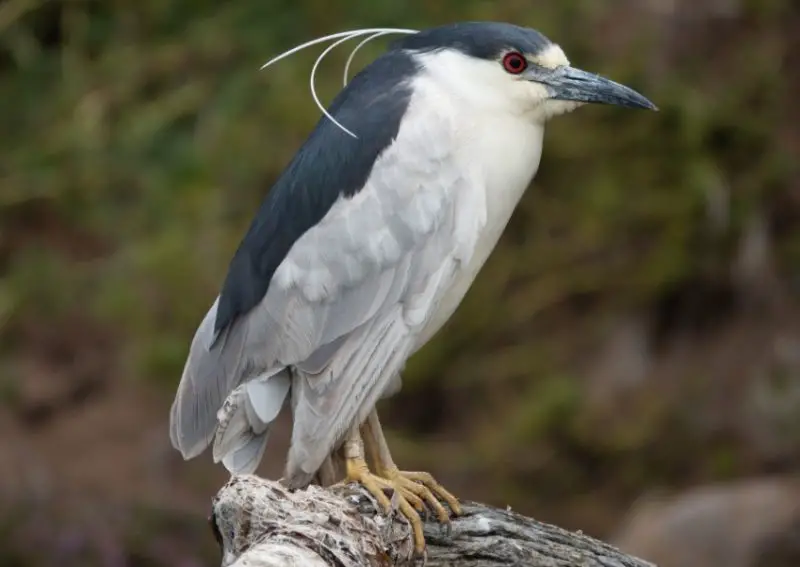
The Black-crowned Night Heron is a robust, medium-sized heron with a thick neck, short legs, and a distinctive nocturnal lifestyle. It has a black crown and back, pale gray wings, and bright red eyes, giving it a striking yet understated appearance. Its short stature and compact body shape make it easily distinguishable from other, more elongated heron species.
This species is most active during twilight and nighttime hours, when it forages for fish, crustaceans, insects, and amphibians. During the day, it often rests quietly in trees or dense marsh vegetation, sometimes in large communal roosts. Juvenile Black-crowned Night Herons look quite different from adults, with brown and white streaked plumage and yellow eyes—a contrast that can cause confusion if not recognized.
Adults typically measure around 23 to 26 inches long with a wingspan of about 45 inches. While not as showy as some of its heron relatives, its stocky build and striking facial features, including the red eyes and thick black bill, make it easily recognizable to experienced birders. During breeding season, adults may develop long, white head plumes.
The Black-crowned Night Heron is common across Florida and breeds in colonies often shared with other wading birds. It inhabits a wide variety of wetland environments including coastal estuaries, freshwater marshes, swamps, and mangrove forests. It is particularly abundant near urban and suburban water bodies where food sources are plentiful, and it can be seen statewide, from the Panhandle to the southern tip.
Yellow-crowned Night Heron (Nyctanassa violacea)

The Yellow-crowned Night Heron is a sleek and elegant wader, slightly more refined in appearance than its black-crowned cousin. It features a gray body, black face, and a distinctive pale yellow or whitish crown that extends from the forehead to the nape. The bird’s eyes are a vivid red, and it has sturdy yellowish legs and a stout, dark bill. During the breeding season, adults display long head plumes and more vibrant facial coloring.
Although also nocturnal, the Yellow-crowned Night Heron can sometimes be seen foraging during the day, particularly at dawn and dusk. It is a specialized crab-eater and often hunts in tidal areas, mudflats, and mangrove swamps, where it patiently stalks crustaceans. Juveniles are browner and heavily streaked with white, similar to young Black-crowned Night Herons, but typically show more uniform spotting and a thinner bill.
This heron measures between 21 and 24 inches in length and has a wingspan of up to 44 inches. Its stocky body and relatively short neck give it a sturdy, compact look. The stout bill and thick legs are adaptations for catching and handling hard-shelled prey like crabs and crayfish, which make up a large portion of its diet.
In Florida, the Yellow-crowned Night Heron is most commonly found in coastal environments, especially mangrove-lined estuaries, tidal creeks, and salt marshes. It is a year-round resident, particularly abundant in southern Florida, including the Everglades, the Florida Keys, and coastal barrier islands. While less commonly found inland, it does occur in urban wetlands and drainage canals where crustaceans are plentiful.
Occasional or Rare Heron-like Birds in Florida
While the following species are not strictly “herons,” they are close relatives and may occasionally be seen in Florida.
Cattle Egret (Bubulcus ibis)
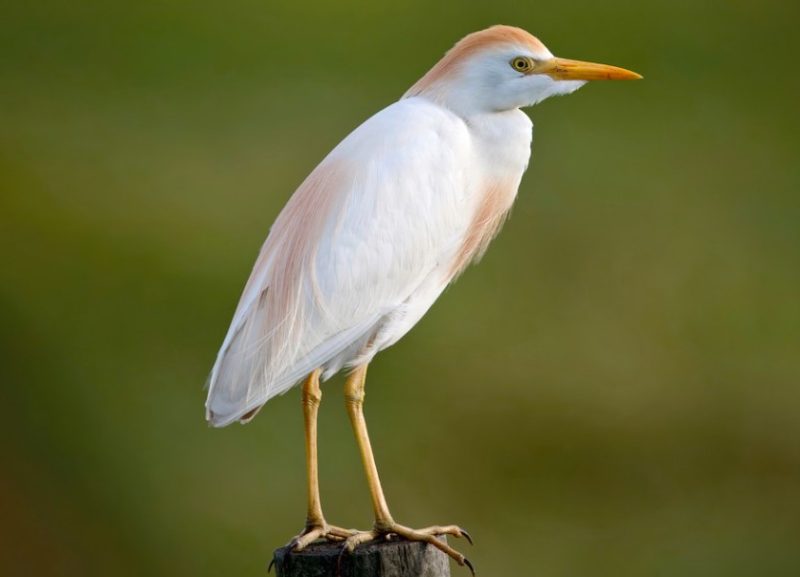
The Cattle Egret is a small, stocky egret that has successfully expanded its range across the globe, originally hailing from Africa and now thriving in Florida and much of the Americas. Unlike many of its heron relatives that are confined to wetlands, the Cattle Egret is often seen in dry, grassy areas, especially near livestock or freshly plowed fields. It has adapted well to agricultural environments, earning its name from the habit of following cattle to catch insects and small animals disturbed by their movement.
This egret is easily recognized by its white plumage, yellow bill, and relatively short legs. During the breeding season, adults develop buff-colored patches on the head, chest, and back, as well as a reddish-orange tinge to the bill and legs. They are smaller than most other egrets, measuring about 18 to 22 inches in length with a wingspan of around 35 inches. Their hunched posture and heavy bill give them a somewhat compact and stout appearance.
Cattle Egrets feed primarily on insects such as grasshoppers, crickets, and flies, as well as frogs, small reptiles, and occasionally fish. Their opportunistic feeding habits and ability to exploit open fields and manmade habitats give them a distinct advantage over more water-bound species. They are frequently seen walking steadily behind tractors or livestock, snatching up prey as it becomes exposed.
In Florida, the Cattle Egret is widespread and very common throughout the state year-round. It can be found in a range of habitats, including pastures, farmland, roadsides, and suburban parks, as well as near wetlands where it roosts and nests. Colonies are often shared with other herons and egrets, particularly in large mixed rookeries. This species has become one of the most familiar and successful herons in Florida’s diverse avian landscape.
American Bittern (Botaurus lentiginosus)
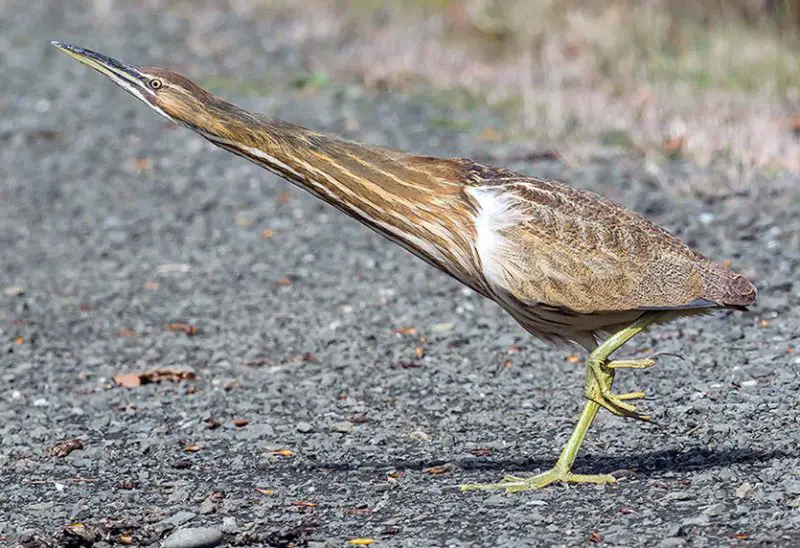
The American Bittern is a master of camouflage, blending almost seamlessly into the reeds and tall grasses of marshes with its brown and buff-streaked plumage. It is a secretive and solitary bird, more often heard than seen, as it freezes in place with its neck extended vertically to match surrounding vegetation. Its booming, gulping call, often compared to the sound of a distant water pump, is a signature sound in its habitat during the breeding season.
This bittern is a medium-sized heron with a thick neck and a strong, dagger-like bill. It has a heavily mottled brown body, pale underparts with dark streaks, and dark brown wings that flash in flight. When alarmed, it will often assume its classic cryptic pose—beak pointed skyward and body motionless—making it nearly invisible among cattails and sedges. Adults measure about 23 to 34 inches in length with a wingspan of 36 to 50 inches.
The American Bittern feeds on fish, frogs, insects, and small mammals, hunting with a slow and deliberate stalking motion. It prefers shallow freshwater marshes and wet meadows with dense vegetation where it can remain hidden. Nesting takes place on platforms built low over the water, concealed among the reeds. Due to its shy behavior and excellent camouflage, it is rarely observed directly, and many birders rely on its call for detection.
In Florida, the American Bittern is mostly a winter visitor and migratory species, seen primarily in northern and central parts of the state. It is uncommon in southern Florida and the Keys. During migration, it may stop over in wetlands across the state, but it tends to favor inland freshwater marshes and wildlife refuges. Its presence in Florida peaks between October and April, when birders may catch a glimpse of this elusive marsh dweller.
Least Bittern (Ixobrychus exilis)
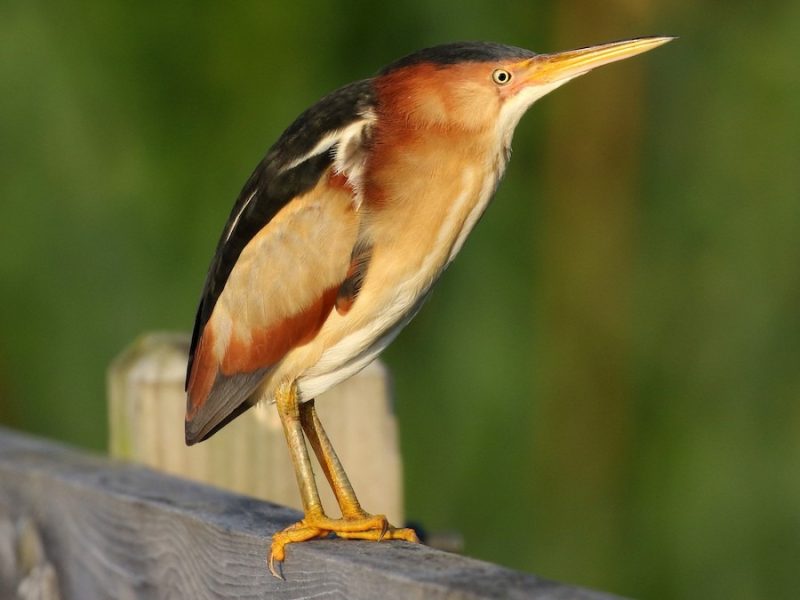
The Least Bittern holds the title of the smallest heron in North America and is among the most elusive birds found in Florida’s wetlands. Measuring only about 11 to 14 inches in length with a wingspan of just 16 to 18 inches, this tiny bird often goes unnoticed as it creeps silently through thick emergent vegetation. Its secretive habits and excellent camouflage make it difficult to spot, though it is often detected by its soft, cooing calls and repetitive “kuk-kuk-kuk” vocalizations.
Its coloration helps it blend perfectly into the reeds. The adult Least Bittern has a chestnut and buff body, with black or dark greenish-black upperparts and crown, and pale underparts. Its yellow bill and legs are proportionally long, and it has a flexible neck that allows it to adopt a vertical “freeze” pose when threatened—an effective defense in dense marshes. Males are generally darker and more vividly colored than females.
Despite its small size, the Least Bittern is an agile and capable hunter. It typically clings to reeds or stalks prey such as insects, small fish, and amphibians while balancing on emergent plants. It prefers dense marshes with cattails, bulrushes, and other tall vegetation, usually over shallow freshwater. Its nests are built low in the reeds, hidden from view and predators.
In Florida, the Least Bittern is found statewide but is especially common in the central and southern parts, including the Everglades and large freshwater marshes. It is a year-round resident, though it may be more vocal and visible during the breeding season in spring and summer. Because of its secretive nature, patience and a keen ear are essential for birders hoping to catch a glimpse of this tiny marsh heron.

